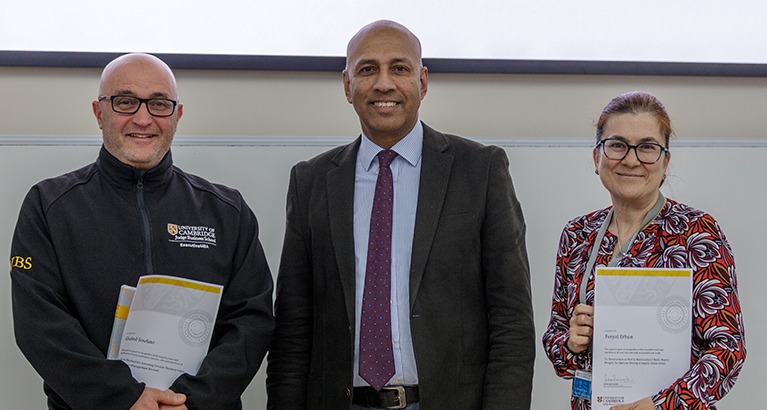The grand or wicked challenges of our times – such as climate change, poverty and inequality of opportunity – are often sought to be addressed through social innovation. But how does social innovation really drive the sort of transformational impact that helps solve those huge challenges? And what are the limitations in practice for social innovation in tackling such huge issues?

Research by Helen Haugh, Associate Professor in Community Enterprise, and colleagues in Africa, Asia and the US, examines these issues by focusing on 3 broad perspectives – scaling, history and systems – to help explain how social innovation drives the sort of transformation to address these grand challenges. In so doing, she sheds light on the promise and drawbacks of these various mechanisms in ways that enrich our insights on social innovation.
“We wanted to move beyond a short-term narrow focus on social impact based on claims of evaluation and responsibility, in favour of a longer-term, big-picture approach that more deeply boosts our understanding,” says Helen. “Given the size and complexity of the problems we face, the focus of social innovation should be on continuous innovating journeys and not on seeking a single solution.”
The research by Helen and her co-authors cites a watershed 1973 article by German and American academics, Dilemmas in a General Theory of Planning, that famously says: “The search for scientific bases for confronting problems of social policy is bound to fail, because of the nature of these problems. They are wicked problems” for which “there are no solutions in the sense of definitive and objective answers.”
Introducing a new framework: scaling, history and systems thinking
With this in mind, Helen and her colleagues introduce a model that draws on various research papers from scholars around the world to reflect on the similarities and differences in how the 3 perspectives of scaling, history and systems answer this key research question: “How do social innovations drive transformational social impact to address grand challenges?” The research is outlined in the introductory article of a book on organisational sociology, which addresses various aspects of social innovation’s promise and limitations.
While there are various definitions of social innovation, the research relies on the definition in a 2014 paper that describes social innovation as “the agentic, relational, situated, and multilevel process to develop, promote, and implement novel solutions to social problems in ways that are directed toward producing profound change in institutional contexts.”
An optimistic view of the promise of social innovation was outlined in a 2018 book by Harvard University academic Steven Pinker, entitled Enlightenment Now: The Case for Reason, Science, Humanism, and Progress. The book struck an upbeat historical tone on some of society’s most wicked problems, noting how issues like hunger, child mortality and pollution had improved markedly over the decades and centuries. The book was widely praised by many organisations involved in social innovation, including the Gates Foundation, for its inspiring message, but others criticised the book as naively disregarding the huge challenges we face at the risk of perpetuating their wickedness.
Context influences how social innovation realises its potential
Helen and her co-authors discuss this book and the debate around it, but then transcend such a relatively narrow look at the advantages and disadvantages of social innovation to focus more broadly on the 3 identified mechanisms for social transformation and the contextual conditions that influence how they may make a real difference in realising social innovation’s potential.
A closer look at these 3 mechanisms:
1
Scaling social innovation: widespread adoption isn’t always enough
Under the scaling perspective, social transformation is seen as a byproduct of the institutionalisation and diffusion of social innovations. Previous research has shown how scaling often operates through an S-shaped curve in which innovation is initially slow to diffuse owing to obstacles and delays, followed by successful initiatives marked by rapid adoption through momentum, and then a slowdown through saturation when the innovation is broadly accepted.
It is widely assumed that social impact will follow the diffusion and institutionalisation of social innovation practices, and this sometimes holds true. For example, the spread of mobile phone technology throughout the world, including to places previously lacking landlines, addressed grand challenges associated with lack of connectivity in remote communities and no access to banking for people in both cities and rural settings. Such newfound connectivity now helps protect rural farmers, through far greater access to information, from exploitation by agricultural intermediaries.
Yet as outlined in a 2019 study that focused on microfinance in Bangladesh, it doesn’t always work that way. Microfinance is widely assumed to be a tool to enable people who lack access to traditional bank loans and other financial services to lift themselves out of poverty through entrepreneurship, but the study showed that societal norms can frustrate such promise. The study focused on a Bangladeshi woman, Latifa, abandoned by her husband, who sought with the assistance of microfinance to set up a self-employed business doing tasks like filling road holes and carrying bricks. But her requests were routinely denied by microfinance officers on grounds that such work is traditionally done by men, so funding a woman to do these activities through self-employment would be disrespectful of the custom of purdah, or the segregating of males and females in Bangladeshi society.
This example shows the limitations of the scaling perspective. “Even when institutionalised and diffused across multiple communities and countries, microfinance operates within the entrenched norms and systems (such as respect for purdah customs) that perpetuate the marginalisation of women like Latifa, leaving them trapped at the bottom of the income pyramid,” says Helen and her co-authors.
2
The historical perspective: lessons from Scottish land reform
The historical perspective on how social innovation can be transformational examines the dynamics of narratives, or the role played by stories that reflect and are shaped by communities, cultural norms, emotions and personal relationships.
“We argue that narratives offer another path to 2 views of the Enlightenment that have long been seen as problematic by humanists – universal rationality and intentionality, by recognising lived experience as a key motivational factor in social innovation and to look beyond intentionality to examine how social innovation has an impact,” says Helen.
In a separate chapter in the book, Helen employs a history-focused perspective through the lens of property rights regime changes over time, particularly the interplay between micro-level action and its macro-level context. While the dominant narrative in western societies has been the protection of private property rights, the study shows how property rights regime change can influence business model social innovation to have beneficial community impacts.
Helen examines how, over many decades, the community of Lewis, an island in northwest Scotland’s windswept Outer Hebrides, developed a social innovation business model to help manage land ownership through such changes in property rights. After a wealthy property owner gifted a huge estate (68,000 acres) to the local community in 1923, a trust was established that shifted the land from private ownership to a common property regime owned by the community, but the traditional business model based on tenant rental income was initially retained. The trust then diversified during World War II, leasing land to the British military and supporting sports activities, and a social business model then emerged after the war to use the land to promote tourism and agriculture while boosting educational and housing opportunities for the island communities.
“The story of the establishment and management of the land trust illustrates the interconnection between the microhistory of the trust and macro events including World War II, and the impact this had on social transformation,” says Helen. “In 1923, when the trust was created, 98% of income from the land was derived from rents and related fees, but by 1960 that declined to 62% of trust income as other income sources such as from field sports and returns on investments increased. “Here we can see through an historical perspective how a change in property rights regime led to diversification of income sources that strengthened the trust’s financial sustainability and also its organisational governance in a way that supports housing development, skills acquisition and other opportunities for the islanders.”
Yet the broader research by Helen also explores how narratives (regardless of veracity) can set back social innovation. Another chapter in the book explains how efforts beginning in the 1960s to tackle homelessness in the US, for example, ran up against a culture of poverty narrative that, in some people’s eyes, dismissed the problem because it was assumed that homeless people were complicit in their fate and thus not deserving of full societal support. “This is in contrast with alternative views that identify factors such as limited welfare services for people with mental illness, or lack of sufficient housing, as the relevant facts when thinking about homelessness,” says the research.
3
Systems perspective and adaptive change in social innovation
The systems perspective focuses on how transformational change can emerge from adaptive change in the interconnections across systems that form the foundation for the grand challenges we face.
The authors reflect that “unlike scaling, which frames transformation as a byproduct of social innovation’s acceptance and spread, or narratives, which focus on cultural and emotional shifts, adaptive change underscores the unpredictability inherent in system complexity and its role in mediating efforts to address grand challenges,.
To illustrate such unpredictability, Helen highlights how well-intentioned efforts by ecologists to protect natural habitats by prohibiting controlled fires have often had unforeseen negative effects, because such controlled blazes can sustain indigenous plant life and slow the spread of alien species, thus lowering the severity of fires that may occur. Likewise, an initiative in El Salvador to donate shoes for every pair sold disrupted local markets and had an unexpectedly negative effect on local communities it was designed to help.
Redefining success in social innovation: a continuous and evolving process
The research by Helen and her academic colleagues elucidates how a big-picture approach, one that embraces a long-term perspective, is key to understanding and unlocking how social innovation can be transformational, while acknowledging the risks or shortcomings of various approaches to addressing the world’s most entrenched problems such as inequality and climate change.
From land reform in Scotland to microfinance in Bangladesh, the book provides accessible content to illustrate how complex mechanisms such as scaling, history and systems can help effect beneficial social change that stands the test of time. Through research by Helen and her colleagues, we understand that social innovation is not a single initiative or a magic solution, but a continual process that can help alleviate social problems through patience and resilience.
Featured research
Dorado, S., Haugh, H., Wadhwani, R.D. and Hamann R. (2025) “Introduction: big picture perspectives on social innovation.” Research in the Sociology of Organizations (forthcoming)





